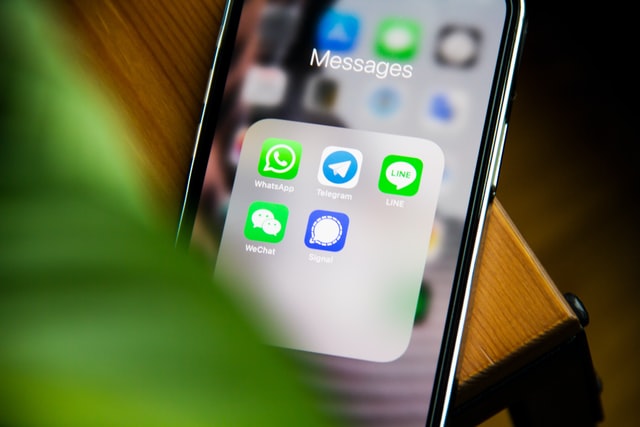SMS Messaging
Text messaging that gets your message to your audience quickly and effectively.

For Millennials, SMS messaging has been a part of life from day one and remains one of the most commonly used methods of communication, even with the rapid growth of mobile messaging apps like Facebook Messenger and WhatsApp.
To understand how the humble SMS message began, we first need to take a trip back in time. German engineer Friedhelm Hillebrand and his French colleague Bernard Ghillebaert were developing a system that would allow written messages to be exchanged through the existing telephone network by making use of unused capacity. The system was based on GSM (Global System for Mobile Communications) standards.
Early in their research, Hillebrand and Ghillebaert found that it was necessary to limit the length of messages to 128 bytes in order to fit into the existing signal formats. This was later improved to 160 characters. Hillebrand argued, based on his analysis of postcards and Telex messages, that this was quite sufficient to express most messages succinctly. It was this same principle that Twitter used to limit characters to 140 (although the social media platform doubled that count to 280 in 2017).
The first commercially sold SMS service was offered to consumers, as person-to-person text messaging, in the early 1990s. Back then GSM mobile phone handsets did not support the ability to send SMS text messages. Nokia was the only handset manufacturer whose complete GSM phone line in 1993 supported user-sending SMS text messages.
Although Hillebrand and Ghillebaert laid the foundations for SMS messaging, it is the Finnish mobile communications engineer Matti Makkonen who is generally credited as the inventor of the SMS text message as we know it today. Makkonen was working for Nokia at the time and helped the company develop the first SMS friendly handsets.
Despite the multinational history of SMS, the first SMS message was sent over the Vodafone GSM network in the United Kingdom in December 1992. It was sent by Neil Papworth of Sema Group using a personal computer to Richard Jarvis of Vodafone using an Orbitel 901 handset. The text of the message was a simple, festive “Merry Christmas.”
While texting is popular today, SMS messaging got off to a surprisingly slow start. In 1995, the average number of messages sent per customer per month was just 0.4. This was, however, largely due to operators rather than customers and restrictions in place on users and who they were able to send and receive messages from. For example, you could not send or receive messages from users outside of your network at that time. It wasn’t until 1999 that an agreement was reached allowing users to send SMS messages to contacts using other networks.
Once initial problems were resolved and restrictions eased, the full power of SMS text messaging was unlocked and numbers quickly rose. By the end of 2000, US users were sending an average of 35 text messages each per month. In 2010, it was reported that 6.1 trillion messages were sent globally – an equivalent of 193,000 SMS messages per second.
Today, 23 billion text messages are sent every day worldwide. From a marketing standpoint, SMS messages have a huge open rate – 98%. Consumers have also shown they like SMS-delivered coupons and redeem them 10 times more than other types of coupons.
Text Enabled Toll-Free numbers, also known as TETF, is a channel that elevates the possibilities of communication for businesses and consumers and does not require a lengthy provisioning process.
Text enabled toll-free numbers give both the business and consumer the option to communicate via telephone and SMS text messaging by way of a 1-800 number. The transition from landlines and phone calls has turned into an SMS-driven marketplace and TETF numbers (toll-free texting) fill this gap by linking your business and business phone number to your consumer’s cellphone.
For example, TETF can be used to send appointment reminders via text message that appear, on the consumer’s cell phone, to come from your business’ toll-free phone number. This makes it more convenient for users to communicate and stay engaged with your business with a phone call or text.

On March 1, 2021, big changes came to the SMS/MMS messaging business. The major carriers decided to no longer allow the use of shared short codes and Person to Person (P2P) long codes.
With shared short codes, it was possible for multiple companies (in some cases thousands) to share one code. Shared short codes were inexpensive but since several companies shared it each one had to use it properly.
If one of those companies violated the rules of the wireless carrier, the carrier would suspend the short code, kick off that one company and then reactivate the code. But now the carriers decided if someone violated the rules the short code was done, shut down for good.
If you have legacy, shared short codes, you can’t get new ones and if you have an audit and a shared code it will get shut down. So, if you want to run text message campaigns, you’ll have to use your own, dedicated short code, a text enabled toll-free number or a 10DLC, which stands for 10-digit long code.
Having your own, dedicated short code or 10DLC makes sense. You won’t have to worry about losing it, like you would if it were shared and other companies broke the rules, causing that shared number to get shut down.
Short codes deliver a high volume of messages in a short amount of time. Short codes’ transactions per second (TPS) start at 100 and can reach 1,000 or more. These codes are great for several campaigns, including communicating to large audiences or sending time-sensitive messages.
Short codes also provide delivery receipts, letting you know which messages were delivered to help you with data analytics and maximizing your campaigns.
A 10DLC looks the same as a P2P long code and has been approved for business use by the carriers. You will though (similar to short codes), need to register your 10DLC and let the carriers know what you’re using it for.
10DLC numbers are sanctioned by the mobile companies so they’re definitely reliable. You can choose a number (or numbers) for different area codes your company operates in. A 10DLC provides 30+ transactions per second (TPS) and they typically come with lower set up and monthly costs than short codes.
If you’re new to SMS/MMS marketing, or you want to start messaging quickly without the higher costs of short codes, a 10DLC makes perfect sense. You could use your 10DLC for:
Talk to a FlowMessage sales representative to discuss the type of campaign you want to run and we’ll help you figure out which code to use to optimize your marketing strategies.
To understand short code provisioning, we first need to understand short codes and their function. A short code is a five to six-digit number used by companies to communicate to their customers via text message. When a company or brand wants to initiate a text marketing campaign the first step is to acquire a short code. This usually means that they will lease a short code and gain access to use this number to reach their customers.
At this point, the code is not actually connected to any of the wireless carriers yet. To activate the short code, you must be approved by the wireless carriers you wish to send messages through. The process of leasing the short code, filling out the application and providing information about the campaigns that will be sent using this short code is called Short Code Provisioning.
The majority of brands and organizations provisioning a new short code will rely on an application provider, like FlowMessage to handle this process for them. This is because an application provider often has a greater understanding of the Campaign Brief Application process and can get your code provisioned quickly with greater ease. Our provisioning time from inception to client contact to live code is 5 weeks.
There are a few options when leasing a short code depending on the style of code you want. There are options to lease a 5-6 digit ‘vanity code’ which would indicate a specialized set of numbers of your choosing, or you can lease a random 5 digit code.
The next step is to file a Short Code Application. This is a step that is typically handled by your application provider and an aggregator. Aggregators are the liaison between the application provider like FlowMessage and the carriers.
Once the wireless carriers have approved your Campaign Brief Application, they’ll activate the new short code on their wireless network. The wireless carriers will initiate short code testing on the code, which includes actually interacting with the short code via text message. Once your short code is approved by the carriers you are then able to send and receive text to users.
As a client of FlowMessage, we, your application provider will expertly guide you through the entire process and manage your short code from leasing to dealing with audits and anything in between.
Text messaging that gets your message to your audience quickly and effectively.
MMS gets your message seen with impressive pictures, video and other interactive features.
Our robust email module includes templates, extensive reporting and more.